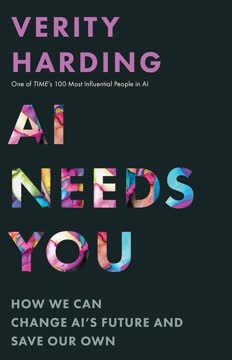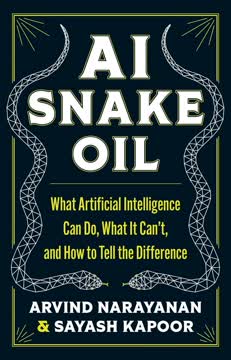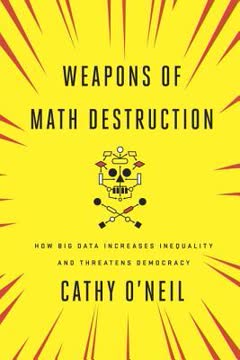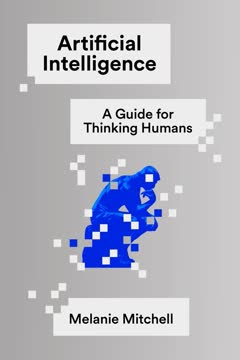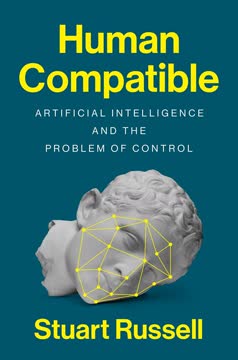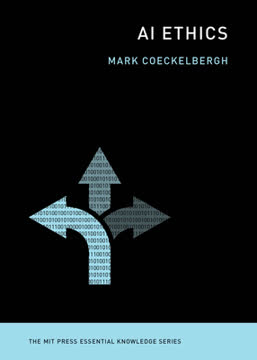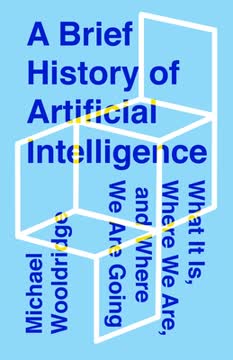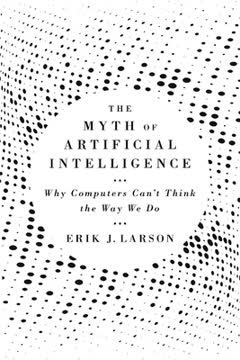نکات کلیدی
1. مبنای مادی هوش مصنوعی: زمین بهعنوان صنعتی استخراجی
رسانههای محاسباتی اکنون در فرآیندهای زمینشناسی و اقلیمی شرکت دارند، از تبدیل مواد زمین به زیرساختها و دستگاهها تا تأمین انرژی این سیستمهای جدید با ذخایر نفت و گاز.
وابستگی هوش مصنوعی به منابع. هوش مصنوعی یک مفهوم انتزاعی نیست، بلکه صنعتی عمیقاً مادی است که به استخراج منابع زمین وابسته است. از معادن لیتیوم در نوادا تا ذخایر مواد معدنی نادر در مغولستان داخلی، ایجاد سیستمهای هوش مصنوعی نیازمند زنجیره تأمین وسیعی از مواد معدنی، انرژی و مواد است. این تقاضا به شیوههای استخراج مخرب محیط زیست دامن میزند که اغلب در بحثهای پیشرفت فناوری نادیده گرفته میشود.
تأثیرات زیستمحیطی. تقاضای بخش فناوری برای منابع بهطور قابل توجهی به تخریب محیط زیست کمک میکند. استخراج مواد معدنی، آبهای زیرزمینی را آلوده میکند، جنگلها را نابود میسازد و جوامع را جابهجا میکند. علاوه بر این، ماهیت انرژیبر هوش مصنوعی، بهویژه در آموزش مدلهای بزرگ، به افزایش ردپای کربن کمک میکند که با صنعت هوانوردی رقابت میکند.
نیاز به تغییر در نگرش. برای درک هزینه واقعی هوش مصنوعی، باید فراتر از وعدههای انتزاعی پیشرفت فناوری برویم و پیامدهای مادی آن را در نظر بگیریم. این نیازمند پذیرش هزینههای زیستمحیطی و انسانی مرتبط با استخراج منابع، مصرف انرژی و زنجیرههای تأمین جهانی است که از سیستمهای هوش مصنوعی پشتیبانی میکنند.
2. هزینه انسانی: استثمار کار در سیستمهای هوش مصنوعی
هماهنگی اقدامات انسانها با حرکات تکراری رباتها و ماشینآلات خط تولید همواره شامل کنترل بدنها در فضا و زمان بوده است.
وابستگی هوش مصنوعی به کار انسانی. با وجود روایت اتوماسیون، سیستمهای هوش مصنوعی به شدت به کار انسانی وابستهاند که اغلب پنهان و با دستمزد پایین انجام میشود. این شامل کارگران دیجیتال که دادهها را برچسبگذاری میکنند، کارمندان انبار آمازون که سفارشات را انجام میدهند و ناظران محتوا که محتوای مضر را فیلتر میکنند، میشود. این کارگران برای عملکرد سیستمهای هوش مصنوعی ضروری هستند، اما سهم آنها اغلب نادیده گرفته میشود و شرایط کاری آنها استثماری است.
زمان و کنترل. مدیریت زمان در استثمار کار در سیستمهای هوش مصنوعی مرکزی است. کارگران تحت نظارت مداوم و ارزیابی الگوریتمی قرار دارند، بهطوریکه هر اقدام آنها پیگیری و اندازهگیری میشود تا حداکثر کارایی حاصل شود. این وضعیت محیط کار استرسزا و غیرانسانی را ایجاد میکند، جایی که کارگران بهعنوان ضمیمههای ماشین تلقی میشوند.
نیاز به همبستگی کارگران. برای مقابله با استثمار کار در سیستمهای هوش مصنوعی، کارگران باید سازماندهی شوند و خواستار بهبود شرایط کاری، دستمزد عادلانه و کنترل بیشتر بر زمان و کار خود شوند. این نیازمند ایجاد همبستگی در بخشهای مختلف صنعت هوش مصنوعی، از معدنکاران تا مهندسان، و به چالش کشیدن ساختارهای قدرتی است که استثمار را تداوم میبخشند.
3. داده بهعنوان زیرساخت: محو زمینه و رضایت
تمام مواد دیجیتال قابل دسترسی عمومی—از جمله دادههای شخصی یا بالقوه مضر—برای برداشت بهمنظور ایجاد مجموعههای دادهای که برای تولید مدلهای هوش مصنوعی استفاده میشوند، باز است.
استخراج داده. صنعت هوش مصنوعی به برداشت انبوه دادهها وابسته است، اغلب بدون رضایت یا توجه به حریم خصوصی. این شامل اطلاعات شخصی، تصاویر و متونی است که از اینترنت جمعآوری شده و برای آموزش مدلهای هوش مصنوعی استفاده میشود. این عمل دادهها را بهعنوان یک منبع رایگان تلقی میکند و از پیامدهای اخلاقی و اجتماعی جمعآوری و استفاده از اطلاعات افراد بدون آگاهی یا اجازه آنها غافل است.
از تصویر به زیرساخت. تبدیل تصاویر به داده، آنها را از زمینه و معنا خالی میکند. عکسهای شناسایی، سلفیها و عکسهای شخصی به نقاط دادهای تبدیل میشوند که برای آموزش سیستمهای شناسایی چهره و سایر مدلهای هوش مصنوعی استفاده میشوند. این محو زمینه میتواند به نتایج جانبدارانه و تبعیضآمیز منجر شود، زیرا سیستمهای هوش مصنوعی یاد میگیرند که ویژگیهای خاصی را با کلیشههای منفی مرتبط کنند.
نگرانیهای اخلاقی. شیوههای کنونی جمعآوری و استفاده از دادهها در هوش مصنوعی نگرانیهای اخلاقی عمیقی را به وجود میآورد. ما باید فراتر از این ایده برویم که دادهها یک منبع خنثی هستند و به دینامیکهای قدرت ذاتی در جمعآوری، برچسبگذاری و استفاده از آنها توجه کنیم. این نیازمند توسعه دستورالعملها و مقررات اخلاقی است که از حریم خصوصی افراد محافظت کرده و از سوءاستفاده از دادههای آنها جلوگیری کند.
4. طبقهبندی بهعنوان قدرت: رمزگذاری تعصب در سیستمهای هوش مصنوعی
با نگاهی به چگونگی ایجاد طبقهبندیها، میبینیم که چگونه طرحهای فنی سلسلهمراتبها را تحمیل کرده و نابرابری را تشدید میکنند.
طبقهبندی بهعنوان یک عمل سیاسی. سیستمهای هوش مصنوعی برای درک جهان به طبقهبندی وابستهاند. با این حال، دستهبندیهای استفاده شده برای طبقهبندی دادهها نه خنثی و نه عینی هستند، بلکه بازتابدهنده تعصبات و فرضیات سازندگان آنها هستند. این تعصبات میتوانند در سیستمهای هوش مصنوعی رمزگذاری شوند و به نتایج تبعیضآمیز منجر شوند.
مسئله تعصب. نشان داده شده است که سیستمهای هوش مصنوعی در حوزههای مختلف، از شناسایی چهره تا عدالت کیفری، تعصب نشان میدهند. این تعصبات اغلب الگوهای تاریخی تبعیض را منعکس میکنند و نابرابریهای موجود را تداوم و تشدید میکنند. بهعنوان مثال، سیستمهای شناسایی چهره ممکن است برای افرادی با پوست تیره دقت کمتری داشته باشند که منجر به شناسایی نادرست و دستگیریهای نادرست میشود.
فراتر از مباحث تعصب. برای حل مسئله تعصب در هوش مصنوعی، باید فراتر از اصلاحات فنی برویم و به ساختارهای اجتماعی و سیاسی زیرین که دادهها و الگوریتمهای مورد استفاده برای آموزش سیستمهای هوش مصنوعی را شکل میدهند، بپردازیم. این نیازمند به چالش کشیدن دینامیکهای قدرتی است که نابرابری را تداوم میبخشند و ترویج رویکردهای عادلانهتر و فراگیرتر در توسعه هوش مصنوعی است.
5. شناسایی احساسات: علم پرچالش خواندن احساسات
راهحل معمای Clever Hans، بهنوشتهی Pfungst، هدایت ناخودآگاه از سوی پرسشگران اسب بود.
ادعای احساسات جهانی. سیستمهای شناسایی احساسات بر این ایده استوارند که احساسات جهانی هستند و میتوانند بهطور قابل اعتمادی از روی حالات چهره شناسایی شوند. با این حال، این ادعا به شدت مورد مناقشه است و بسیاری از محققان بر این باورند که احساسات متغیرهای فرهنگی و وابسته به زمینه هستند.
تأثیر پل اکرمن. کارهای روانشناس پل اکرمن در شکلگیری حوزه شناسایی احساسات تأثیرگذار بوده است. تحقیقات اکرمن که از دهه 1960 آغاز شد، ادعا میکرد که مجموعهای از احساسات پایهای را شناسایی کرده است که بهطور جهانی ابراز و شناسایی میشوند. با این حال، روشها و یافتههای او بهدلیل عدم دقت علمی به شدت مورد انتقاد قرار گرفته است.
نگرانیهای اخلاقی. با وجود تردیدهای علمی در مورد شناسایی احساسات، این ابزارها بهسرعت در زمینههای مختلف با ریسک بالا، از استخدام تا پلیس، به کار گرفته میشوند. این موضوع نگرانیهای اخلاقی جدی را به وجود میآورد، زیرا افراد ممکن است بر اساس ارزیابیهای نادرست و غیرقابل اعتماد از وضعیت عاطفی خود قضاوت و مورد تبعیض قرار گیرند.
6. هوش مصنوعی بهعنوان ابزاری از قدرت دولتی: نظارت و کنترل
گذشته و حال نظامی هوش مصنوعی، شیوههای نظارت، استخراج داده و ارزیابی ریسک را که امروزه مشاهده میکنیم، شکل داده است.
ریشههای نظامی هوش مصنوعی. توسعه هوش مصنوعی به شدت تحت تأثیر تأمین مالی و اولویتهای نظامی قرار دارد. این موضوع بر تمرکز این حوزه بر نظارت، استخراج داده و ارزیابی ریسک تأثیر گذاشته و به پیامدهای اخلاقی و اجتماعی توجهی نمیکند.
آرشیو اسنودن. آرشیو اسنودن نشان میدهد که تا چه حد نهادهای اطلاعاتی از هوش مصنوعی برای جمعآوری و تحلیل دادهها بهصورت انبوه استفاده کردهاند. این ابزارها که زمانی برای مقاصد امنیت ملی اختصاص داده شده بودند، اکنون بهطور داخلی به کار گرفته میشوند و مرزهای بین نظارت نظامی و غیرنظامی را محو میکنند.
استراتژی سومین جبران. استراتژی سومین جبران ارتش ایالات متحده بهدنبال حفظ تسلط خود در هوش مصنوعی با همکاری با بخش فناوری است. این موضوع منجر به رابطه نزدیکی بین ارتش و سیلیکونولی شده است، بهطوریکه شرکتهای فناوری ابزارها و تخصصهای هوش مصنوعی را به وزارت دفاع ارائه میدهند.
7. خانههای بزرگ هوش مصنوعی: متمرکز کردن قدرت و گسترش نابرابریها
این سیاستها توسط خانههای بزرگ هوش مصنوعی هدایت میشوند که شامل چندین شرکت است که بر محاسبات سیارهای در مقیاس بزرگ تسلط دارند.
تمرکز قدرت. صنعت هوش مصنوعی تحت تسلط تعداد کمی از شرکتهای فناوری قدرتمند است. این شرکتها مقادیر زیادی داده، منابع و تخصص را کنترل میکنند و به آنها مزیت قابل توجهی در شکلدهی به توسعه و استقرار سیستمهای هوش مصنوعی میدهد.
گسترش نابرابریها. تمرکز قدرت در دستان چند غول فناوری، نابرابریهای موجود را تشدید میکند. سیستمهای هوش مصنوعی اغلب بهگونهای طراحی میشوند که به منافع این شرکتها خدمت کنند و فاصله بین ثروتمندان و فقیران، قدرتمندان و حاشیهنشینان را بیشتر کنند.
نیاز به مقررات. برای مقابله با تمرکز قدرت در صنعت هوش مصنوعی، به مقررات قویتری نیاز داریم که رقابت را ترویج کرده، حریم خصوصی را محافظت کند و اطمینان حاصل کند که سیستمهای هوش مصنوعی بهنحوی استفاده میشوند که به نفع جامعه بهطور کلی باشد. این نیازمند به چالش کشیدن تسلط غولهای فناوری و ترویج اشکال دموکراتیکتر و پاسخگوتر از حاکمیت هوش مصنوعی است.
8. به چالش کشیدن منطقها: بهسوی جنبشهای متصل برای عدالت
با تغییر شرایط زمین، باید خواستههای حفاظت از دادهها، حقوق کار، عدالت اقلیمی و برابری نژادی را بهطور همزمان شنید.
جنبشهای متصل. برای حل مشکلات بنیادی هوش مصنوعی، نیاز به ارتباط مسائل قدرت و عدالت داریم. این شامل حفاظت از دادهها، حقوق کار، عدالت اقلیمی و برابری نژادی است. با همکاری، این جنبشها میتوانند به چالش ساختارهای قدرتی بپردازند که هوش مصنوعی در حال حاضر تقویت میکند.
سیاستهای رد. ما باید ایدهای را که هوش مصنوعی اجتنابناپذیر است و هیچ انتخابی جز پذیرش پیامدهای آن نداریم، رد کنیم. این نیازمند به چالش کشیدن روایتهای تعیینگرایی فناوری و خواستار اشکال دموکراتیکتر و پاسخگوتر از حاکمیت هوش مصنوعی است.
چشمانداز متفاوت. با ارتباط مسائل قدرت و عدالت، میتوانیم چشمانداز متفاوتی برای هوش مصنوعی ایجاد کنیم، چشماندازی که به رفاه انسانی، پایداری زیستمحیطی و برابری اجتماعی اولویت میدهد. این نیازمند به چالش کشیدن منطقهای استخراجی هوش مصنوعی و ساختن آیندهای عادلانهتر و پایدارتر برای همه است.
آخرین بهروزرسانی::
FAQ
What's Atlas of AI about?
- Exploration of AI's Impact: Atlas of AI by Kate Crawford delves into the profound implications of artificial intelligence on society, politics, and the environment. It critiques the portrayal of AI as a neutral technology, highlighting its entanglement with power structures and extractive industries.
- Critique of AI Myths: The book challenges the notion that AI can replicate human intelligence, emphasizing that intelligence is shaped by cultural and historical contexts. Crawford uses examples like Clever Hans to illustrate biases in systems claiming objectivity.
- Interconnected Systems: Crawford presents AI as a "megamachine" reliant on a vast network of resources, including human labor and natural materials, urging readers to consider the broader implications of AI technologies on human rights and social justice.
Why should I read Atlas of AI?
- Critical Perspective: The book offers a critical lens on AI, challenging readers to think about the ethical and social ramifications of technology. It encourages a deeper understanding of how AI systems are designed and the biases they may perpetuate.
- Broader Context: Crawford situates AI within a larger framework of extraction and exploitation, linking it to historical and contemporary issues of power and inequality. This context is crucial for understanding the societal impacts of AI.
- Engaging Narratives: Combining rigorous research with compelling storytelling, the book makes complex topics accessible and engaging. Readers will find a blend of academic analysis and real-world examples that illustrate the stakes involved in AI development.
What are the key takeaways of Atlas of AI?
- AI as a Power Structure: The book posits that AI reflects existing power structures, serving the interests of those in control. AI systems are not neutral but are designed to optimize for specific outcomes that often reinforce inequality.
- Environmental and Labor Costs: Crawford highlights the significant environmental impact of AI, particularly in terms of resource extraction and energy consumption, and reveals how AI systems rely on cheap labor from marginalized communities.
- Call for Justice: Crawford advocates for a movement towards justice that addresses the interconnectedness of technology, capitalism, and social equity. She urges readers to consider how AI can be reoriented to serve the public good rather than perpetuate harm.
What are the best quotes from Atlas of AI and what do they mean?
- "Artificial intelligence is a registry of power.": This quote encapsulates Crawford's argument that AI systems reflect and reinforce existing power dynamics rather than being impartial technologies. It suggests that understanding AI requires examining who benefits from its deployment.
- "The story of Clever Hans is a cautionary reminder that you can’t always be sure of what a model has learned from the data it has been given.": This highlights the potential for bias in AI systems, emphasizing that the data used to train models can lead to misleading conclusions.
- “AI systems are expressions of power that emerge from wider economic and political forces.”: This quote challenges the reader to critically assess who benefits from AI technologies, emphasizing that AI is not neutral but reflects and amplifies existing power dynamics.
How does Kate Crawford define artificial intelligence in Atlas of AI?
- Not Artificial or Intelligent: Crawford argues that AI is neither truly artificial nor genuinely intelligent. Instead, it is a complex interplay of human labor, natural resources, and socio-political structures.
- Embodied and Material: She emphasizes that AI systems are built from physical materials and depend on extensive infrastructures, which include energy and labor. This challenges the common perception of AI as a purely digital phenomenon.
- Political and Social Practices: Crawford asserts that AI is shaped by political and social practices, meaning it cannot be understood in isolation from the contexts in which it operates.
What is the Clever Hans Effect mentioned in Atlas of AI?
- Observer-Expectancy Effect: The Clever Hans Effect refers to the phenomenon where a subject performs based on unintentional cues from the observer rather than genuine understanding. This highlights the influence of biases in interpreting intelligence.
- Implications for AI: Crawford uses this effect to illustrate how AI systems can also be misinterpreted based on the data they are trained on and the expectations of their creators.
- Broader Context of Intelligence: The effect raises questions about how intelligence is defined and measured, suggesting that our understanding of intelligence is often shaped by cultural and contextual factors.
How does Atlas of AI address the environmental impact of AI?
- Resource Extraction: Crawford discusses the extensive mining and resource extraction required to power AI technologies, particularly the demand for rare earth minerals, leading to significant ecological damage.
- Energy Consumption: The book highlights the enormous energy demands of AI systems, particularly in data centers, which contribute to carbon emissions and climate change.
- Interconnectedness with Climate Justice: Crawford connects the environmental impact of AI to broader issues of climate justice, arguing that the exploitation of resources for AI disproportionately affects marginalized communities.
What role does labor play in the construction of AI according to Atlas of AI?
- Exploitation of Workers: Crawford reveals how AI systems rely on cheap labor, often sourced from vulnerable populations, to function effectively. This exploitation is a critical aspect of the AI industry.
- Digital Piecework: The book discusses the rise of digital piecework, where workers are paid minimal amounts to perform tasks that support AI systems, such as labeling data.
- Surveillance and Control: Crawford highlights how AI technologies increase surveillance and control over workers, leading to a more regimented and exploitative work environment.
How does Atlas of AI address the issue of data extraction?
- Data Colonialism: Crawford discusses how data extraction often mirrors colonial practices, where marginalized communities are exploited for their data without consent or benefit.
- Consent and Privacy: The book emphasizes the lack of informed consent in data collection practices, particularly in how personal data is harvested for AI training.
- Impact on Communities: The extraction of data can have detrimental effects on communities, reinforcing existing inequalities and injustices.
What critiques does Atlas of AI offer regarding emotion recognition technologies?
- Scientific Foundations Questioned: Crawford highlights that many emotion recognition technologies are based on flawed scientific assumptions, particularly the idea that facial expressions universally correspond to specific emotions.
- Cultural Bias: The book points out that emotion recognition systems often fail to account for cultural differences in emotional expression, leading to biased outcomes.
- Potential for Harm: Crawford warns that deploying these technologies without understanding their limitations can lead to harmful consequences, such as misinterpretation of individuals' emotional states.
How does Atlas of AI connect AI to state power?
- Surveillance and Control: Crawford discusses how AI technologies are increasingly used by state actors for surveillance and control, often without adequate oversight.
- Military Applications: The book explores the relationship between AI development and military applications, particularly through programs like Project Maven.
- Corporate-State Collaboration: Crawford highlights the collaboration between tech companies and government agencies, suggesting that this partnership can lead to a lack of accountability and transparency.
What are the implications of Atlas of AI for the future of technology?
- Reevaluation of AI Development: Crawford's work calls for a reevaluation of how AI technologies are developed and deployed, emphasizing the need for ethical considerations and social responsibility.
- Advocacy for Justice Movements: The book encourages readers to engage in justice movements that address the intersections of technology, labor, and environmental issues.
- Critical Engagement with AI: Crawford urges readers to critically engage with AI technologies, questioning their implications and advocating for transparency and accountability.
نقد و بررسی
کتاب اطلس هوش مصنوعی نظرات متفاوتی را به خود جلب کرده است. برخی از منتقدان به بررسی انتقادی تأثیرات اجتماعی و زیستمحیطی هوش مصنوعی در این کتاب اشاره کرده و آن را ستایش میکنند، در حالی که دیگران به نوشتار تکراری و کمبود راهحلها در آن انتقاد میکنند. خوانندگان از بررسی هزینههای مادی هوش مصنوعی، استثمار نیروی کار و نگرانیهای اخلاقی در این کتاب قدردانی میکنند. با این حال، برخی آن را بیش از حد بدبینانه و فاقد عمق فنی میدانند. این کتاب به خاطر رویکرد جامع خود مورد تحسین قرار گرفته، اما به خاطر لحن آکادمیک و گاهی عدم تمرکز نیز مورد انتقاد قرار میگیرد. با وجود کاستیهایش، بسیاری آن را کتابی مهم برای درک پیامدهای گستردهتر هوش مصنوعی میدانند.
Similar Books
